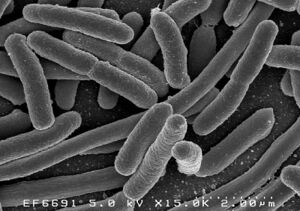Enterohemorrhagic Escherichia coli
Escherichia coli is a gram-negative bacteria that is a common commensal of the large and small intestine. E. coli causes:
- specific diarrheal diseases - mainly in infants but also in adults;
- non-specific intestinal (mostly exogenous infection) and extraintestinal diseases (mostly endogenous infection).
Strains carrying the body antigen O157 are referred to as EHEC (enterohemorrhagic E. coli), sometimes also as STEC (shiga-like toxigenic) or VTEC (verotoxigenic).[1].
Penetration into the body is similar to other strains. The microbes then adhere to the brush border of the enterocytes. Verotoxin (shiga-like toxin) then passes into the bloodstream through the disrupted epithelium, which leads to erythrocyte damage and platelet aggregation and the subsequent formation of hyaline thrombi. Together with the released substances from damaged epithelium (especially endothelin), thrombi thus contribute to the failure of blood flow through the kidneys and the so-called hemolytic-uremic syndrome develops.
Disruption of the intestinal mucosa is associated with leakage of fluids and blood into the intestine. This leads to severe bloody diarrhea that is similar to shigellosis.
Therapy[edit | edit source]
- lighter forms - p.o. rehydration, hungry diet;
- more severe forms - hospitalization, parenteral treatment of homeostasis;
- ATBs are not commonly used, optionally aminoglycosides;
- otherwise adsorbents (Smecta®), charcoal and disinfection (Endiaron®).
Links[edit | edit source]
Related articles[edit | edit source]
- ↑ HORÁČEK, Jiří. Základy lékařské mikrobiologie. 1. edition. Karolinum, 2000. ISBN 80-246-0006-4.

